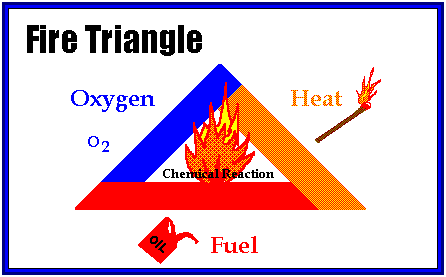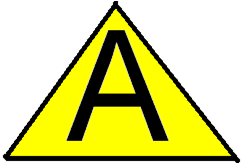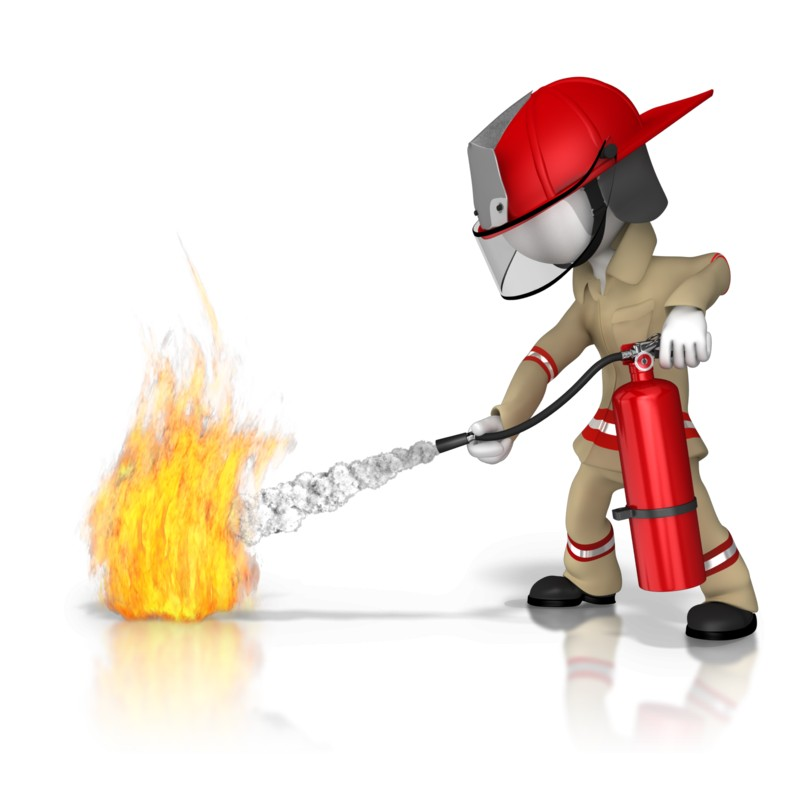The Fire Triangle

Fire Safety, at its most basic, is based upon the picture of keeping fuel sources and ignition source separate.
- Enough OXYGEN to sustain combustion +
- Enough HEAT to each ignition temperature +
- Some FUEL or combustible materia = Together, they produce the CHEMICAL REACTION, that is fire
 FIRE CLASSIFICATION
FIRE CLASSIFICATION- Fire are classified according to the type of fuel that is burning.
- If you use the wrong type of fire extinguisher on the wrong class of fire, you might make matters worse.
- It very important to understand the four different fire (fuel) classification...
Class B : Flammable liquids - gasoline, acetone, oil, grease, petrol etc.
- Most of fire extinguisher will have a pictograph label telling you which types of fire extinguisher is designed to fight.
- For examle, a simple water extinguisher might have a label like this

- W/Co2 is designed for class A Fire only : Wood, paper, cloth & combustible material.
- Using water on flammable liquid fire could cause the fire to spread.
- Using water on an electrical fire increases the risk of electrocution. If you have no chice but to use a W/Co2 on an electrical fire, make sure the electrical equipment is unplugged on de - energized.
- Foam is a powerfulknockdown agent for spill fires involving inflammable liquids. This extinguisher forms a thick later of foam over the burning surface, effectively cutting of atmospheric supply of oxygen to the burning surfce there by something the fire and preventing re-ignition. Foam extinguisher fire by giving blanketing effect.
- Mechanical Foam (AFFF) extinguish fire by taking "heat" & "Oxygen" element of the fire triangle.
- AFFF's are designed for Class A & B Fires : Petrol, oil, naphtha, paints, alcohols & solvents.
- Using Foam on an electrical fire increases the risk of electrocution. If you have no choice but to use a Foam on an elcetircal fire, make sure the electrical equipment is un-plugged or de-energized.
- AFFF Foam will be foumd in older buildings, particularly in petrol pumps, as well as oil depots.
- They will also be found in refineries & petrochemical industries. It is important to remember, however, that all electrical equipmet must be disconnected foam its electrical source before using a foam extinguisher on it.
3. Carbon Dioxide Fire Extinguishers :
- The pressure in a Co2 extinguisher is so great, bits of dry ice may shoot out of the horn !
- Co2's are designed for B & C ( Flammable liquids and Electrical Sources) Fires only !
- Co2s will frequently be found in laboratories, mechanical rooms, Sophisticated Electronic Equipments Room, SERVER ROOM and flammable liquid storage areas.
- Carbon dioxide is a non - flammable gas that takes away the oxygen element of the fire triangle. Without oxygen, there is no fire.
- CO2 is very cold as it comes out of the extinguisher, so it cools the fuel as well.
- A CO2 may be ineffective in extinguishing a class A Fire because it may not be able to displace enough oxygen to successfully put the fire out.
- Class A materials may also smolder and re-ignite.
- ABC Dry chemical extinguishers put out fire by coating the fuel with a thin layer of dust. This separates the fuel from the oxygen in the air.
- The powder also works to interrupt the chemical reaction of fire. These extinguisher are very effective at putting out fire.
- ABC extinguisher are red. on campus, they range in size from 500 GMS. to 9 Kgs.
- "ABC" fire extinguisher are filled with a fine yellow colour powder. The geatest portion of this powder. The gratest portion of this powser is composed of mono ammonium phosphate. The extinguishers are pressurized with dry nitrogen gas.
- It is extremely important to identify which types of dry chemical extinguisher are located in your are!

- An " ABC " extinguisher will have a label like this, indicating it may be used on Class A, B and C Fires.
- You don't want to by mistake use "BC" extinguisher on Class A Fire thinking that it was an " ABC extinguisher.
- Dry chemical extinguishers put out fire by coatingthe fuel wiht a thin layer of dust. This separates the fuel from the oxygen in the air.
- These extinguishers are very effective at putting out class B & C Fires.
- Dry chmical extinguishers with powder designed for class B and C fires ("BC" extinguishers) may be located in places such as commercial kichens and areas with flammable liquids.
- On campus. you will find ABC's & BC's in new buildings, in laboratories, break rooms, offices, chemical storage areas, mechanical rooms, etc.
- Dry Chemival powder extinguishers come in a such of types...
- you may see them labeled :
- Dry Chemical Powder
- ABC ( can be used on Class A, B, or C fires)
- BC (designed for use on class B and C fires)
4 (C). Clean Agent (ABC) Fire Extinguishers :
Clean Agent "ABC" fire extinguisher are filled with clean agent type (hcfc) type chemical. Clean Agent fire extinguisher are Eco friendly & non Ozone harming substance. Also there is no residue operation.
- It's easy to remember how to use a fire extinguisher if you remember the acronym PASS :
- Pull
- Aim
- Squeeze
- Sweep
- Pull the pin or safety clip.....
- This will allow you to discharge the extinguisher
- Aim at the base of the fire...
- Hit the fuel
- If you aim at the flames the extinguishing agent will fly right through and do no good.
- Squeeze, rotate or hit the top of the handle...
- This depresses a pin that releases the pressurized extinguishing agent.
- Sweep from side to side until the fire is completely out.
- start using the fire extinguisher from a safe distance away, then slowly move forward.
- once the fire is out, keep an eye on the area in case it re - ignites.

Rules For Fighting Fires
- Fire can be very dangerous and you should always be certail that. you will not endanger yourself or otheras when attempting to put out a fire.
- For this reason , when a fire is discovered....
- Assist any person in immediate danger to safety, if it can be accomplished without risk to yourself.
- Call 101 or activate the building fire alaram. The fire alaram will notify the department and other building occupants and shut off the air handling (A. C) system to prevent the spread of smoke.
- If the fire is small ( and only after having done these 2 things), you may attempt to use an extinguisher to put it out.
- However before deciding to fight the fire, keep these things in mind :
- Know what is burning : If you don't know what's burning, you won't know what kind of extinguisher to use.
- Eeven if you have an ABC fire extinguisher, there may be something in the fire that is going to explode or produce toxic fumes.
- Chances are you will know what's burninng, or at least have a pretty good idea, but if you don't, let the fire department handel it.
- Is the fire spreading rapidly beyond the point where it started ? The time to use an extinguisher is at the beginning stages of the fire.
- IF the fire is already spreading quickly, it is best to simply evacuate the building.
- As you evacuate a building, close doors and windows behind you as you leave. This will help to slow the spread of smoke and fire. Make sure that no one is left before you close the doors.
Do not fight the fire if :
- You don't have adequate of appropriate equipment. If you don't have the correct type or large enough extinguisher, it is best not try fighting the fire.
- You might inhale toxic smoke. When synthetic materials such as the nylon in carpeting or foam padding in sofa burn, they can produce hydrogen cyanide and ammonia in addition to carbon monoxide. These gases can be fatal in very small amounts.
- You instincts tell you not to. If you are uncomfortable with the situation for any reason, just let the fire department to do their job.
- The final rule is to always positions yourself with an exit or means of escape at your back before you attempt to use an extinguisher to put out a fire.
- in case the extinguisher malfunctions, or something unexpected happens, you need to be able to get out quickly. You don't want to become trapped.
Our Message to Industries
Fire Safety should not remain as a slogan, management must look into it. Fire Safety makes sense from the point of view of economics as well as for the healthy environment. All developed countries have found that it si some viable to install fire Fighting & Safety Systems rather than to bear the losses due to fire.
Our survey revealed that effective use of well Maintained fire fighting & Safety equipments resulted into saving hundreds of Human Lives as well as Property worth crores of rupees. Every organization can save by going through the statutory fire safety audit & following proper procedure & recommendations for the installation of toatal Safety equipments. This shall Minimize fire losses & you shall continue your operation with total safety of your man & material.
All companies must organize workshops for their respective dept personnel's with the competent authorities. This way they can help to save the company from fire losses & Precious Life, Ultimately in saving huge amount for the industry as whole.
PRANAV ENTERPRISE
#Fire extinguisher Dealer & Refilling in Ahmedabad, Gujarat.
